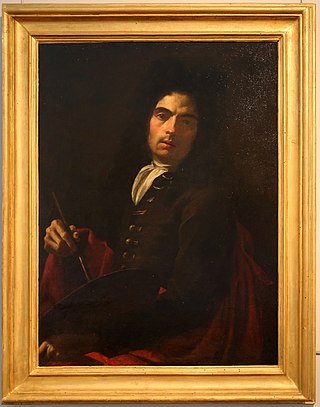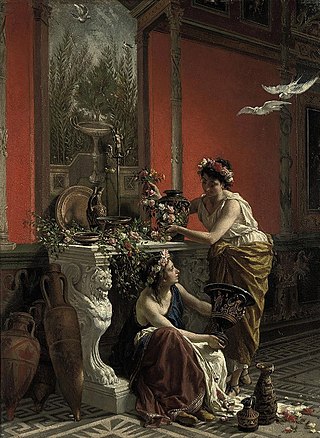Giovanni Giordano Lanza (April 1827 - in or after 1889) was an Italian painter.

Giovanni Giordano Lanza (April 1827 - in or after 1889) was an Italian painter.

He was born in Naples, Kingdom of the Two Sicilies. He completed his first studies under professor Giacinto Gigante in Naples. In 1852, his large canvas of The Interior of the church of Santa Chiara was awarded a silver medal. He was commissioned by the Bourbon royal family to paint The interior of the Sacristy of San Martino, which was also awarded a prize. In 1860 by commission of the marchese di Sassenay and for an album of Napoleon III, he completed two watercolors depicting Una veduta della marina di Santa Lucia and An Interior of the Gerolimini . In 1862, he completed by commission by the Prince of Cassero a canvas depicting the Palazzo Reale of Caserta; in 1862 again for the royal family, he completed a Sant'Arcangelo alla Cova; per Vittorio Emanuele, he painted la Veduta della Piazza d'Amalfi; for the Duchess of Genoa Naples of Mergellina . He also completed another canvas depicting The Surroundings of Naples(1875). [1]
Documentation of him in Naples exist as late as 1889. [2]

Luca Giordano was an Italian late-Baroque painter and printmaker in etching. Fluent and decorative, he worked successfully in Naples, Rome, Florence, and Venice, before spending a decade in Spain.

Sebastiano Conca was an Italian painter.

Corrado Giaquinto was an Italian Rococo painter.

Giovanni Lanfranco was an Italian painter of the Baroque period.

Ferdinando Fuga was an Italian architect who was born in Florence, and is known for his work in Rome and Naples. Much of his early work was in Rome, notably, the Palazzo della Consulta (1732–7) at the Quirinal, the Palazzo Corsini (1736–54), the façade of the Santa Maria Maggiore (1741–3), and the Church of Sant'Apollinare (1742–8). He later moved to Naples and notably designed the Albergo de'Poveri (1751–81), the façade of the Church of the Gerolamini, and that of the Palazzo Giordano.

The Church and Convent of the Girolamini or Gerolamini is a church and ecclesiastical complex in Naples, Italy. It is located directly across from the Cathedral of Naples on via Duomo. The facade is across the homonymous piazza and street from Santa Maria della Colonna. It is one block west of Via Duomo.

Santa Maria la Nova is a Renaissance style, now-deconsecrated, Roman Catholic church and monastery in central Naples. The church is located at the beginning of a side street directly across from the east side of the main post office, a few blocks south of the Church and Monastery of Santa Chiara. Today the adjacent monastery is a meeting site and hosts the Museo ARCA of modern religious art.

Santa Caterina a Formiello is a church in Naples, in southern Italy, located at the extreme eastern end of the old historic center of the city, on Via Carbonara and Piazza Enrico de Nicola, near the gate called Porta Capuana. The term Formiello comes from the forms or containers for water spouts found in the convent. Diagonally across the street and South is the Fontana del Formiello against the rear wall of the imposing Castel Capuano.

Marcello Venusti was an Italian Mannerist painter active in Rome in the mid-16th century.

Cesare Mariani was an Italian painter and architect of the late-19th century, active in Rome and Ascoli Piceno.

The Church of Pietà dei Turchini is a religious building in Naples, Italy. A smaller church, located on Rua Catalana, was built originally in 1592–1595 by the Confraternity of the Incoronatella. This church was nearly destroyed by an explosion in the Castel Nuovo in 1638. It was rebuilt in 1638–1639, and retitled Santa Maria Incoronatella della Pietà dei Turchini when it acquired a dome. The facade was completed in 1769–70 by Bartolomeo Vecchione.

Santa Maria degli Angeli a Pizzofalcone is a Baroque-style church in Naples, Italy.

Teofilo Patini was an Italian painter, active in a Realist style.

Raffaele Armando Califano Mundo was an Italian painter.
Raffaelle Spanò (1817–1863) was an Italian painter.

Napoleone Verga was an Italian painter, mainly of illuminated manuscripts, but also of paintings.
Orsola Faccioli or Licata Faccioli was an Italian painter, mainly of vedute and interior scenes.
Francesco Autoriello was an Italian painter, mainly depicting historical canvases.

The church of Santa Maria Maggiore della Pietrasanta is a Roman Catholic religious edifice located on Via Tribunali in central Naples, Italy.

Giuseppe Drugman was an Italian landscape and cityscape painter.